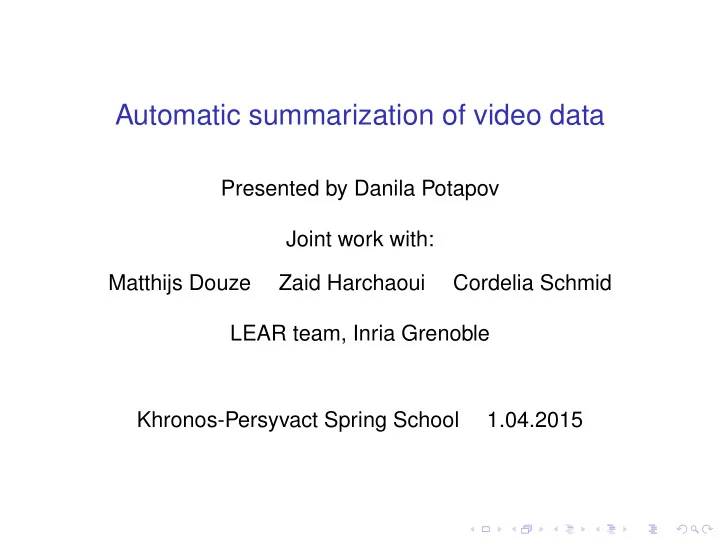

Automatic summarization of video data Presented by Danila Potapov Joint work with: Matthijs Douze Zaid Harchaoui Cordelia Schmid LEAR team, Inria Grenoble Khronos-Persyvact Spring School 1.04.2015
Definition A video summary ◮ built from subset of temporal segments of original video ◮ conveys the most important details of the video Original video, and its video summary for the category “Birthday party”
Overview of our approach ◮ produce visually coherent temporal segments ◮ no shot boundaries, camera shake, etc. inside segments ◮ identify important parts ◮ category-specific importance : a measure of relevance to the type of event Input video (category: Working on a sewing project) KTS segments Per-segment classification scores Maxima Output summary
Contributions ◮ temporal video segmentation algorithm ◮ novel approach for supervised video summarization ◮ MED-Summaries : dataset for evaluation of video summarization
Kernel temporal segmentation ◮ input: robust frame descriptor (SIFT + Fisher Vector) ◮ kernelized Multiple Change-Point Detection algorithm ◮ solved exactly with dynamic programming in O ( mn 2 ) ◮ optimization criterion: minimize the sum of within-segment variances ◮ automatic calibration of the number of change points with a BIC-like regularizer − 0.25 0.00 0.25 0.50 0.75 1.00 Kernel matrix and temporal segmentation of a video
Supervised summarization ◮ Training: Train a linear SVM from a set of videos with just video-level class labels. ◮ Testing: Score segment descriptors with the classifiers trained on full videos. Build a summary by concatenating the most important segments of the video. Input video (category: Working on a sewing project) KTS segments Per-segment classification scores Maxima Output summary
MED-Summaries dataset ◮ 100 test videos (= 4 hours) from Trecvid MED 2011 ◮ multiple annotators ◮ 2 annotation tasks: ◮ segment boundaries (median duration: 3.5 sec.) ◮ segment importance (grades from 0 to 3) importance segments periods Central frame for each segment with importance annotation for category “Changing a vehicle tyre”.
Evaluation metrics for summarization (1) ◮ often based on user studies ◮ time-consuming, costly and hard to reproduce ◮ Our approach: rely on the annotation of test videos ◮ ground truth segments { S i } m i = 1 ◮ computed summary { � S j } ˜ m j = 1 � � S i ∩ � ◮ coverage criterion: duration S j > α P i period period covered by the summary t ground truth covers the ground-truth summary no match ◮ importance ratio for summary � S of duration T total importance I ( � I ∗ ( � S ) covered by the summary S ) = I max ( T ) max. possible total importance for a summary of duration T
Evaluation metrics for summarization (2) ◮ a meaningful summary covers a ground-truth segment of importance 3 1 2 0 3 3 importance 3 segments are required ground truth to see an importance-3 segment summary 0.7 0.5 0.9 classification score Meaningful summary duration (MSD): minimum length for a meaningful summary ◮ segmentation f-score : match when overlap/union > β
Experiments Baselines ◮ Users : keep 1 user in turn as a ground truth for evaluation of the others ◮ SD + SVM : shot detector (Massoudi, 2006) for segmentation + same importance scoring ◮ KTS + Cluster : same segmentation + k-means clustering for summarization ◮ sort segments by increasing distance to centroid Our approach ◮ KVS = KTS + SVM
Results Method Segmentation Summarization Avg. f-score Med. MSD (s) higher better lower better Users 49.1 10.6 SD + SVM 30.9 16.7 KTS + Cluster 13.8 41.0 KVS 41.0 12.5 Segmentation and summarization performance 52 50 Importance ratio 48 Users SD + SVM 46 KTS + Cluster 44 KVS-SIFT KVS-MBH 42 40 38 10 15 20 25 Duration, sec. Importance ratio for different summary durations
Examples summaries Uniform sampling Birthday party Our video summary 0.189 0.151 0.122 0.077 0.055 Uniform sampling Changing a vehicle tire Our video summary 0.096 0.081 0.036 0.034 0.026 Uniform sampling Parade Our video summary 0.309 0.089 0.064 0.047 0.032
Conclusion ◮ KVS delivers short and highly-informative summaries, with the most important segments for a given category ◮ KVS is trained in a semi-supervised way ◮ does not require segment annotations in the training set ◮ MED-Summaries — publicly available dataset ◮ annotations and evaluation code available online: http://lear.inrialpes.fr/people/potapov/
Thank you for your attention!
References ◮ MED-Summaries dataset lear.inrialpes.fr/ people/potapov/med_summaries.php ◮ D. Potapov, M. Douze, Z. Harchaoui, C. Schmid “Category-specific video summarization”, ECCV 2014 ◮ Related work ◮ M. Sun et al. “Ranking Domain-specific Highlights by Analyzing Edited Videos”, ECCV 2014 ◮ M. Gygli et al. “Creating Summaries from User Videos”, ECCV 2014
Recommend
More recommend